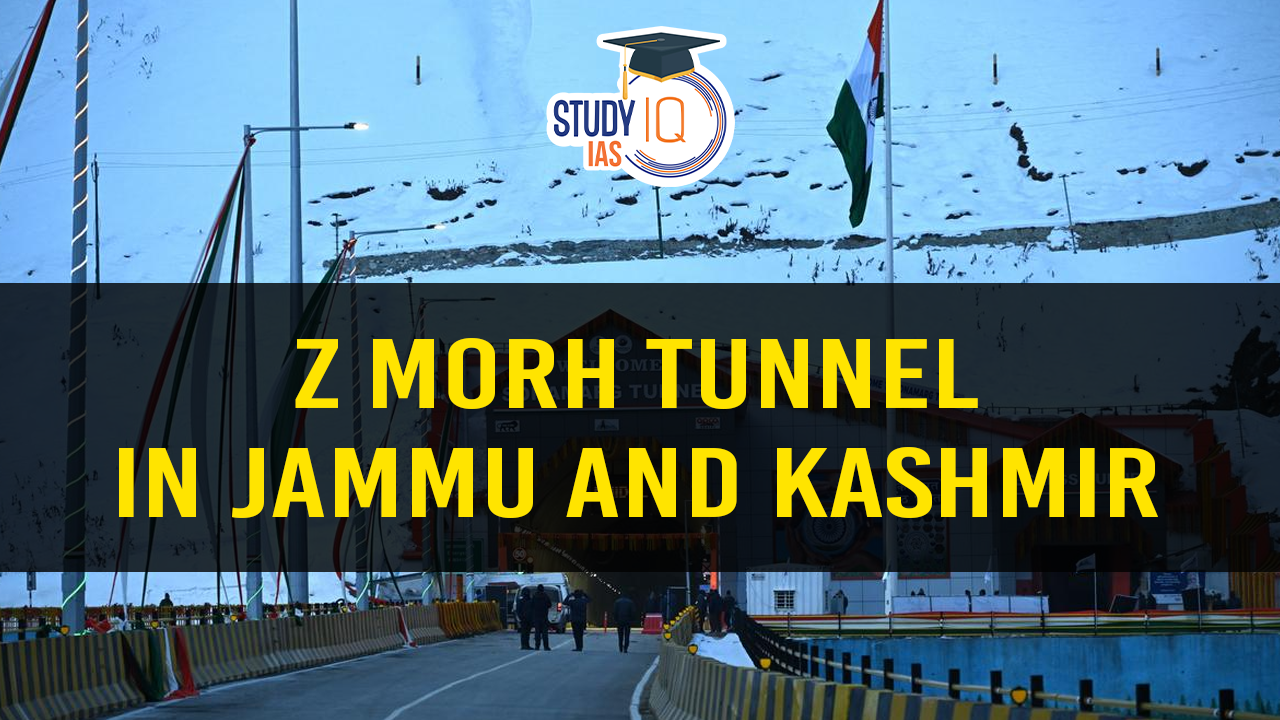Table of Contents
The Z-Morh Tunnel, a significant infrastructure project in Jammu and Kashmir, is poised to revolutionize connectivity in the region. This 6.5 km long tunnel, inaugurated by Prime Minister Narendra Modi in January 2025, is part of a larger effort to improve road infrastructure and bolster national security. As UPSC aspirants, understanding the strategic, economic, and socio-political implications of such projects is essential for exams, particularly in subjects like Geography, International Relations, and General Studies.
What is the Z-Morh Tunnel?
The Z-Morh Tunnel is a bi-directional, two-lane tunnel located in the Ganderbal district of Jammu and Kashmir. The project, constructed at an altitude of 8,650 feet, aims to provide year-round connectivity between Srinagar and the Sonamarg region, which previously faced severe weather disruptions, especially during winter. The tunnel is part of the Srinagar-Leh National Highway (NH-1), connecting vital areas, including Ladakh, with the rest of India.
| Details | |
|---|---|
| Name | Z-Morh Tunnel |
| Location | Ganderbal district, Jammu and Kashmir |
| Length | 6.5 km |
| Elevation | 8,650 feet |
| Cost | Rs 2,700 crore |
| Construction Start Date | May 2015 |
| Completion Date | 2023 (Soft launch in February 2024) |
| Purpose | Ensuring year-round connectivity to Sonamarg and Ladakh, improving defense logistics, boosting tourism. |
| Type | Bi-directional, two-lane tunnel with a 7.5-meter-wide emergency escape passage. |
| Strategic Importance | Enhances national defense logistics and ensures continuous access to the Ladakh region. |
| Safety Features | Includes an emergency escape passage for safety; bypasses avalanche-prone zones. |
| Economic Impact | Boosts tourism to Sonamarg and Ladakh, facilitates regional trade, and promotes economic development. |
| Technological Features | Advanced construction techniques, third lane on approach road, environmental sensitivity in construction. |
| Complementary Infrastructure | Works in tandem with the Zojila Tunnel (expected completion by 2028) to further improve Srinagar-Leh access. |
| Completion Status | Fully operational as of 2024. |
Strategic Importance of the Z-Morh Tunnel
- National Security: The Z-Morh Tunnel is crucial for India’s national defense strategy. The Ladakh region, which is strategically located near borders with China, benefits immensely from improved road access. The tunnel facilitates better transportation for military logistics, ensuring quick mobilization and defense preparedness in the region.
- Disaster Mitigation: By bypassing avalanche-prone zones, the tunnel enhances commuter safety, reducing the risk of accidents and ensuring uninterrupted travel between Srinagar and Ladakh, even during harsh winter months.
- Strategic Location: Positioned at an elevation of 8,650 feet, the tunnel is constructed under the Thajiwas Glacier, a challenging location that demonstrates India’s capability to execute high-altitude infrastructure projects.
Economic and Socio-Political Impact
- Tourism: The Z-Morh Tunnel will be a game-changer for tourism in Jammu and Kashmir. By ensuring all-weather access to Sonamarg, a popular tourist destination, it is expected to boost the local economy by attracting more tourists year-round. Additionally, it will enhance the tourism appeal of Ladakh, contributing to the region’s economic growth.
- Regional Connectivity: For civilians, the tunnel reduces travel time significantly, improving access to Ladakh. This will not only ease the commute for civilians but also open up opportunities for trade, commerce, and cultural exchange between Jammu and Kashmir and the rest of India.
- Infrastructure Development: The tunnel is part of a broader push by the Indian government to modernize infrastructure in Jammu and Kashmir and Ladakh. It will pave the way for further development projects, including the Zojila Tunnel, which will provide seamless connectivity between Srinagar and Leh, further enhancing road transportation efficiency.
- Employment and Local Development: The construction of the tunnel has generated significant employment opportunities, especially in the local population. As a result, the project has had positive socio-economic effects on the region, including skill development and livelihood creation for workers involved in the construction phase.
Technological Features of the Z-Morh Tunnel
- Advanced Construction Techniques: The tunnel is built using modern technology, including a 7.5-meter-wide emergency escape passage running parallel to the main structure. This is particularly important for ensuring the safety of commuters during unforeseen circumstances.
- Traffic Management: The project also includes the construction of a third lane on the approach road to manage traffic flow efficiently, allowing for smoother movement of both slow-moving and faster vehicles.
- Environmental Considerations: The construction of the Z-Morh Tunnel was designed with sensitivity to the environment. It ensures minimal disruption to the surrounding ecosystems, particularly the Thajiwas Glacier, which is an important local landmark.
Zojila Tunnel and the Larger Infrastructure Vision
The Z-Morh Tunnel works in tandem with the ongoing Zojila Tunnel project, which, when completed by 2028, will further reduce the distance between Srinagar and Ladakh from 49 km to 43 km. This reduction in travel distance will also lead to increased vehicle speeds, improving the overall efficiency of road travel in the region.
Conclusion
The Z-Morh Tunnel is a critical infrastructure project that will not only enhance connectivity but also strengthen India’s defense logistics, boost tourism, and promote socio-economic development in Jammu Kashmir and Ladakh. For UPSC aspirants, it is vital to understand the multifaceted impact of such infrastructure developments, as they intersect with national security, economic growth, regional development, and environmental sustainability. This project is an essential case study for topics like infrastructure development, security concerns, and socio-economic challenges in the UPSC General Studies syllabus.


 100 Years of CPI: Origins, Ideology, Fre...
100 Years of CPI: Origins, Ideology, Fre...
 Santhali Language: History, Script, Cons...
Santhali Language: History, Script, Cons...
 Why India Needs Its Own Economic Model?
Why India Needs Its Own Economic Model?

























